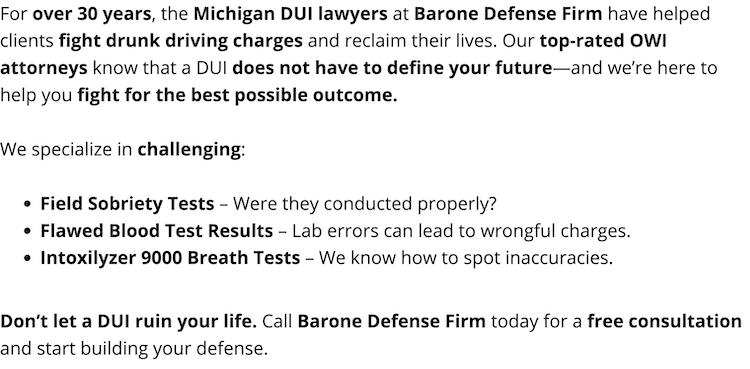Reviewing the Evidence in a DUI Case
In making the decision whether or not to retain The Barone Defense Firm for your pending drunk driving case, you are probably wondering how we will be evaluating and defending your case, and how we might use our knowledge of your case and of the law and science of drunk driving to win in court.
In short, we will do this by calling into question both the arresting officer's description of what happened as well as the reliability of the chemical (breath or blood test) evidence. This section addresses only the officer's description of the case. Defenses to the chemical evidence are described elsewhere on this website.
Building a Robust Defense
Once you've retained us to represent you, then in evaluating your case and preparing your defense The Barone Defense Firm will be assessing and comparing the arresting officer's description of the offense with the videotape of the roadside (if any). We will then compare these items with the principles and concepts taught by the National Highway Traffic Safety Administration (NHTSA) to determine if the officer complied with these standards during the investigation of your case.
Our evaluation will include a determination by us as to whether or not the Standardized Field Sobriety Tests (SFST's) were administered by the officer as part of the pre-arrest screening, and if so, then whether or not they were administered in strict adherence to NHTSA's standardized protocol. The ultimate goal of this assessment is to help us show at trial that the arresting officer's proposed testimony is not reliable.
What follows is a description of the SFST's and the proper way they are to be administered. This is being provided to you to help you better understand how we will defend your case.
Standardized Field Sobriety Tests
The National Highway Traffic Safety Administration has developed standardized procedures for the administration of the three FSTs which NHTSA considers the most reliable. These standardized FSTs (SFSTs) are taught to and used by police officers across the country.
The SFSTs are designed to be used by police officers to establish probable cause to arrest individuals who are under suspicion of driving while intoxicated and to support the administration of a breathalyzer test which measures more directly a person's blood alcohol content (BAC). As direct, independent evidence of intoxication, however, SFSTs are extremely unreliable and have an immense margin of error. Furthermore, individual officers often administer the tests differently or under non-ideal testing circumstances, further reducing their reliability.
The NHTSA police officer training course separates the typical DUI investigation into three "phases". These are (1) Vehicle in Motion, (2) Personal or Face-to-Face Contact, and; (3) Pre-Arrest Screening. The SFST's are administered during phase three as part of the pre-arrest screening, and include only the Horizontal Gaze Nystagmus (HGN), the Walk-and-Turn (WAT), and the One-Leg Stand (OLS). If any other field tasks were administered in your case, or if these three tests were not given together, then the officer did not follow the NHTSA protocol.
In reviewing the following information you should think about what the officer did in your case, and whether or not this varied from the following standardized procedures.
Horizontal Gaze Nystagmus
"Nystagmus" is an involuntary twitching of the eye. This twitching is what the officer was looking for when he/she told you at the roadside "I am going to check your eyes". In administering this test, the officer was looking for three things:
- Lack of smooth pursuit
- Distinct Nystagmus at maximum deviation
- Onset of Nystagmus prior to 45 degrees
If the test had been appropriately administered, the officer would have begun by asking you to stand with your feet together, and arms at your side. You should then have been instructed to "follow the stimulus (usually the officer's finger, a pen, or a flashlight) with your eyes only, keeping your head still". Before beginning the test, the officer should have confirmed that you understood the instructions by directly asking you "Do you understand"? The officer should also have asked you if you were wearing contact lenses.
The officer should have then checked your eyes for "equal tracking" and also should have confirmed that you had equal pupil size. These determinations require one full pass (a full pass begins at the nose, and then continues first the driver's right, then back to center, to the driver's left, then back to center again).
The test should have continued with the officer checking both of your eyes for "lack of smooth pursuit" (The officer is looking for the involuntary jerking as your eyes move from side to side). This determination requires two full passes, and each pass should have taken a minimum of four seconds.
In the next part of the test, the officer is looking for "Nystagmus at maximum deviation". (Maximum deviation occurs when the eye is brought all the way out toward the shoulder, and no white is visible at the outside of the eye). To perform this correctly, the officer should again have made two full passes, and should have held your eye at maximum deviation for a minimum of four full seconds.
Next, the officer should have checked for onset of Nystagmus prior to 45 degrees. Here the officer should have brought your eyes out from center very slowly and should have noted the angle of onset. Once the officer saw the angle of onset (if indeed the officer did see Nystagmus), then the officer should have stopped to verify its onset and occurrence. Again, this determination would have required two full passes. Finally, the officer should have checked for vertical Nystagmus. This should have been done by moving your eyes vertically once, and should have taken at least four seconds.
Having evaluated hundreds of these cases it is evident that officers almost never administer this test properly. What is most unsettling is that administering this test incorrectly can actually cause the Nystagmus that the officer will later use against you to prove you were intoxicated!
The two things that almost every officer mistakenly does when administering this test is to move the stimulus too fast and to complete the test with too few passes. Another frequent mistake is to have the driver facing toward the patrol vehicle. The flashing lights from the patrol vehicle can also cause involuntary twitching.
Walk and Turn
When properly administered, this test is composed of two stages, the instruction stage and the walking stage. As with the HGN, there is a very specific protocol that officer should have followed in administering both stages of this test. During the instruction stage, you should have been instructed as follows:
Verbal Instructions:
- Place your left foot on the line (demonstrate).
- Place your right foot in front of left, with heel of right foot against toe of the left foot (demonstrate).
- Keep your arms down at your sides (demonstrate).
- Keep this position and don't start until told.
- DO YOU UNDERSTAND?
Once you indicated that you understood, the officer should have instructed you to walk nine heel-to-toe steps forward, and then turn keeping your lead foot on the line and taking several small steps with your other foot, then walking nine heel-to-toe steps back. Both the steps and the turn should have been demonstrated by the officer. The officer should then have instructed:
While Walking:
- Keep watching your feet,
- Keep your arms down at your sides,
- Count your steps out loud,
- Don't stop while walking until you complete the test.
- DO YOU UNDERSTAND?
Walk and Turn Test Clues:
According to NHTSA, there are eight visual clues that the officer looks for, and if he/she observes at least two of the eight, you will be considered to have failed the test.
- Can't balance during instructions
- Starts too soon
- Stops while walking
- Doesn't touch heel to toe
- Steps off the line
- Uses arms for balance
- Improper turn (or loses balance on turn)
- Wrong number of steps
(Note: If you can't do the test, the officer will record the results as if all 8 clues were observed).
The most common mistakes most officers make with this test are to give incorrect instructions, and/or to ask the driver to count an incorrect number of steps. The test conditions are usually also not appropriate. (The NHTSA manual addresses the need for appropriate conditions). A failure to give the instructions exactly as stated above, and/or a failure to use the standardized scoring method, further reduces the reliability of this "intoxication" evidence.
One Leg Stand
When properly administered, this test is also composed of two stages, the instruction stage and the balance and counting stage. As with the HGN and WAT, the OLS also has a very specific protocol that officer is to follow in administering both stages this test. During the instruction stage, you should have been instructed as follows:
Instruction Stage
- Stand straight, with your feet together,
- Keep your arms at your sides,
- Maintain this position until told otherwise.
- DO YOU UNDERSTAND?
Once you indicated that you understood, the officer should next have instructed:
Balance and Counting Stage
- Raise one leg, either leg;
- Keep raised leg approximately six inches (15 cm) off the ground, foot pointed out;
- Keep both of your legs straight;
- Keep your eyes on elevated foot;
- Count out loud in the following manner: 1001, 1002, 1003, and so on, until told to stop
(Note: It is important for the officer to time the 30 second count for the test, i.e., during the proper administration, the officer should have timed you during the balance and counting stage to see if you could hold your foot in this position for 30 seconds).
One Leg Stand Test Clues
According to NHTSA, there are four visual clues that the officer looks for, and if he/she observes at least two of the four, you will be considered to have failed the test. The four test clues are:
- Sways while balancing
- Uses arms to balance
- Hops
- Puts foot down
Note: If you can't do the test, the officer will record as if all four clues were observed.
The most common mistakes most officers make with this test are to give incorrect instructions, and/or to ask the driver to count incorrectly or for an inappropriate time period. As with the WAT, the test conditions for the OLS are usually also not appropriate. (The NHTSA manual addresses the need for appropriate conditions).
How an Attorney Can Help
A major goal in the defense of every drunk driving case is to show the jury that the opinions and conclusions of the police officer are not correct, or stated another way, that they are not reliable. If we can persuade the jury that the prosecutor's case is based on unreliable evidence then they should agree that there is a reasonable doubt of your guilt.
If your case does go to trial then we hope to bring out all of the discrepancies and problems with the prosecutor's evidence, including problems with your "pre-arrest screening". We will do this when we "cross-examination" (question) the arresting officer. Later, when we have a chance to directly address the jury (during closing argument), we will explain to the jury how the officer did not follow his/her own training, and how this means that there is "reasonable doubt" as to your guilt.
When you look at the evidence in your case the questions you should be asking yourself are whether or not the arresting officer followed his/her own training, whether or not the right tests were administered, and whether or not the tests were administered in the right way.These are very important questions because these failures can significantly reduce the impact of the police officer's testimony at trial, and perhaps even create a reasonable doubt as to your guilt.
 Barone Defense Firm Home
Barone Defense Firm Home




















